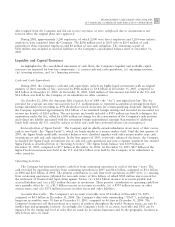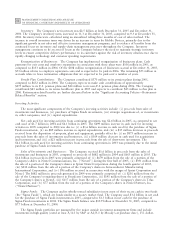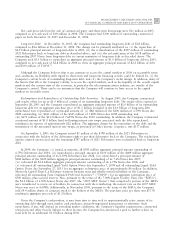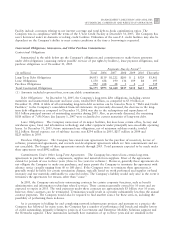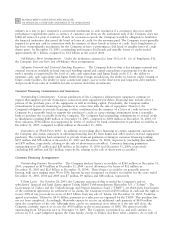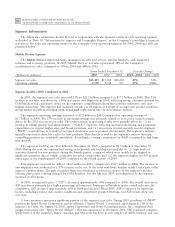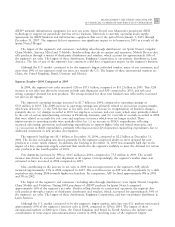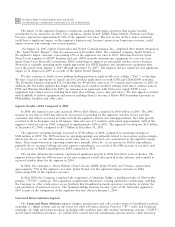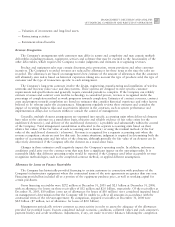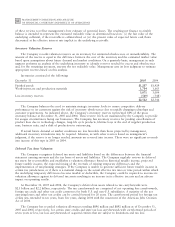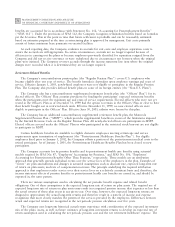Motorola 2005 Annual Report Download - page 68
Download and view the complete annual report
Please find page 68 of the 2005 Motorola annual report below. You can navigate through the pages in the report by either clicking on the pages listed below, or by using the keyword search tool below to find specific information within the annual report.
61
MANAGEMENT'S DISCUSSION AND ANALYSIS
OF FINANCIAL CONDITION AND RESULTS OF OPERATIONS
iDEN»network infrastructure equipment for over ten years. Sprint Nextel uses Motorola's proprietary iDEN
technology to support its nationwide wireless service business. Motorola is currently operating under supply
agreements for iDEN handsets and infrastructure equipment that cover the period from January 1, 2005 through
December 31, 2007. The segment did not experience any significant impact to its business in 2005 as a result of the
Sprint Nextel Merger.
The largest of the segment's end customers (including sales through distributors) are Sprint Nextel, Cingular,
China Mobile, Amπerica M πovil and T-Mobile. Besides selling directly to carriers and operators, Mobile Devices also
sells products through a variety of third-party distributors and retailers, which account for approximately 36% of
the segment's net sales. The largest of these distributors, Brightstar Corporation, is our primary distributor in Latin
America. The loss of any of the segment's key customers could have a significant impact on the segment's business.
Although the U.S. market continued to be the segment's largest individual market, many of our customers, and
more than 60% of our segment's total net sales, are outside the U.S. The largest of these international markets are
China, the United Kingdom, Brazil, Germany and Mexico.
Segment ResultsÌ2004 Compared to 2003
In 2004, the segment's net sales increased 52% to $17.1 billion, compared to $11.2 billion in 2003. This 52%
increase in net sales was driven by increases in both unit shipments and ASP compared to 2003, and reflected
strong consumer demand for new products. The strong demand for these new handsets was reflected by increased
net sales in all regions.
The segment's operating earnings increased to $1.7 billion in 2004, compared to operating earnings of
$511 million in 2003. The 238% increase in operating earnings was primarily related to an increase in gross margin,
which was driven by: (i) the 52% increase in net sales, and (ii) a decrease in reorganization of business charges,
primarily due to: (a) charges recorded in 2003 for employee severance and exit costs, which were primarily related
to the exit of certain manufacturing activities in Flensburg, Germany, and (b) reversals of accruals recorded in 2004
that were related to accruals for exit costs and employee severance which were no longer needed. These
improvements to operating results were partially offset by: (i) an increase in SG&A expenditures, reflecting
increased advertising, promotion and marketing expenditures to support higher sales and brand awareness, and
(ii) an increase in R&D expenditures, primarily reflecting increased developmental engineering expenditures due to
additional investment in new product development.
The segment's backlog was $1.5 billion at December 31, 2004, compared to $2.2 billion at December 31,
2003. The decline in backlog was driven primarily by the segment's improved ability to meet demand for new
products in a more timely manner. In addition, the backlog at December 31, 2003 was unusually high due to the
impact of a key component supply constraint that resulted in the segment's inability to meet the demand for certain
new products in the fourth quarter of 2003.
Unit shipments increased by 39% to 104.5 million in 2004, compared to 75.3 million in 2003. The overall
increase was driven by increased unit shipments in all regions. Correspondingly, the segment's market share was
estimated to have increased in 2004 compared to 2003.
Also contributing to the increase in net sales in 2004 was an improvement in the segment's ASP, which
increased approximately 15% in 2004 compared to 2003. The overall increase in ASP was driven primarily by a shift
in product mix during 2004 towards higher-tier handsets. By comparison, ASP declined approximately 8% in 2003
and 5% in 2002.
The largest of the segment's end customers (including sales through distributors) were Sprint Nextel, Cingular,
China Mobile and Vodafone. During 2004, purchases of iDEN» products by Sprint Nextel comprised
approximately 16% of the segment's net sales. Besides selling directly to carriers and operators, the segment also
sold products through a variety of third-party distributors and retailers, which accounted for approximately 30% of
the segment's net sales. The largest of these distributors, Brightstar Corporation, and was our primary distributor in
Latin America.
Although the U.S. market continued to be the segment's largest market, sales into non-U.S. markets represented
approximately 60% of the segment's total net sales in 2004, compared to 52% in 2003. The largest of these
international markets in 2004 were China, the United Kingdom and Brazil. In North America, the industry saw
consolidation of some major telecommunications carriers in 2004, involving some of the segment's largest


